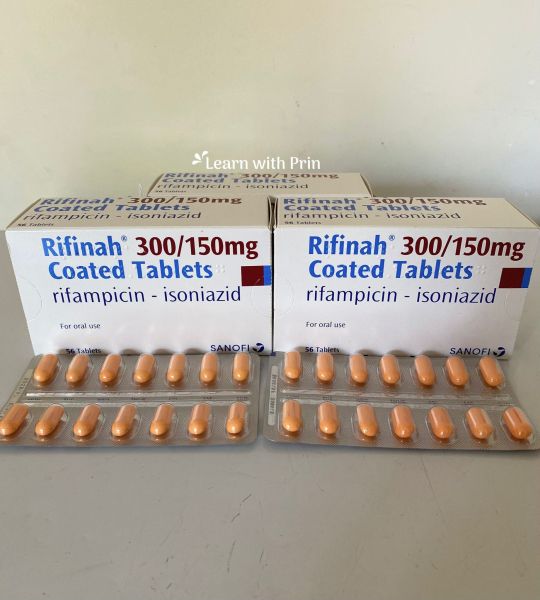#Rifampicin
Explore tagged Tumblr posts
Text

Rifampicin (ไรแฟมพิซิน)
Rifampicin (ไรแฟมพิซิน)
Rifampicin (ไรแฟมพิซิน) คือ ยาปฏิชีวนะที่ทางการแพทย์ใช้ป้องกันหรือรักษาวัณโรค รักษาการติดเชื้อในจมูกและลำคอจากแบคทีเรียบางชนิดที่เป็นสาเหตุของโรคเยื่อหุ้มสมองอักเสบ โรคไข้กาฬหลังแอ่นชนิดเยื่อหุ้มสมองอักเสบ หรือโรคติดเชื้อชนิดอื่น รวมทั้งช่วยป้องกันการแพร่เชื้อดังกล่าวไปสู่ผู้อื่น แต่จะไม่นำมาใช้รักษาโรคเยื่อหุ้มสมองอักเสบในระยะที่แสดงอาการแล้ว

เกี่ยวกับ Rifampicinกลุ่มยายาปฏิชีวนะประเภทยายาตามใบสั่งแพทย์ สรรพคุณป้องกันหรือรักษาวัณโรค รักษาโรคเยื่อหุ้มสมองอักเสบในระยะยังไม่แสดงอาการกลุ่มผู้ป่วยเด็กและผู้ใหญ่รูปแบบของยายารับประทาน ยาฉีดเข้าเส้นเลือด

คำเตือนการใช้ยา Rifampicin
หากเคยมีประวัติแพ้ไรแฟมพิซิน ยา อาหาร หรือสารชนิดอื่น ๆ ควรแจ้งให้แพทย์ทราบก่อนใช้ยา
ไม่ควรใช้ยาชนิดนี้ หากกำลังใช้ยาต้านเชื้อเอชไอวี เช่น ซาควินาเวียร์ ริโทนาเวียร์ เป็นต้น เนื่องจากยาไรแฟมพิซินอาจทำให้ประสิทธิภาพของยาต้านเชื้อเอชไอวีลดลง
ห้ามฉีดวัคซีนทุกชนิดขณะใช้ยาไรแฟมพิซิน เพราะอาจทำให้ประสิทธิภาพของวัคซีนลดลง ยกเว้นกรณีที่แพทย์แนะนำ
แจ้งประวัติการเจ็บป่วยให้แพทย์ทราบ โดยเฉพาะผู้ป่วยโรคเบาหวาน โรคตับ โรคติดเชื้อเอชไอวี หรือผู้ที่มีประวัติติดแอลกอฮอล์ เพราะยาไรแฟมพิซินอาจส่งผลให้อาการของโรคนั้น ๆ รุนแรงขึ้น หรืออาจทำปฏิกิริยากับยาชนิดอื่นที่กำลังรับประทานอยู่
หากกำลังใช้ยา สมุนไพร หรือผลิตภัณฑ์เสริมอาหารชนิดใดก็ตาม ควรแจ้งให้แพทย์ทราบก่อนใช้ยาชนิดนี้
หลีกเลี่ยงการดื่มแอลกอฮอล์ขณะใช้ยา
ห้ามใส่คอนแทคเลนส์ขณะใช้ยา เนื่องจากยาไรแฟมพิซินอาจทำให้สีของน้ำตาเปลี่ยนไป ส่งผลให้เกิดคราบติดบนคอนแทคเลนส์อย่างถาวรได้
ผู้ที่กำลังใช้ยาไรแฟมพิซินต้องแจ้งให้แพทย์ทราบก่อนวางแผนผ่าตัดหรือรับการรักษาทางทันตกร��ม
ห้ามขับรถ ใช้เครื่องจักร หรือทำกิจกรรมที่มีความเสี่ยงสูงขณะใช้ยา เพราะยาชนิดนี้อาจมีผลข้างเคียงทำให้รู้สึกวิงเวียนศีรษะหรือง่วงซึม
ยาไรแฟมพิซินอาจส่งผลให้ยาคุมกำเนิดมีประสิทธิภาพลดลง ขณะใช้ยานี้จึงควรใช้วิธีคุมกำเนิดด้วยรูปแบบอื่นที่ไม่ใช้ฮอร์โมนแทน เช่น ถุงยางอนามัย ห่วงคุมกำเนิด เป็นต้น
หญิงตั้งครรภ์และหญิงที่กำลังให้นมบุตรควรแจ้งให้แพทย์ทราบก่อนใช้ยาและควรใช้ยาเมื่อจำเป็นเท่านั้น เพราะการใช้ยาไรแฟมพิซินในช่วงก่อนคลอด 2-3 สัปดาห์ อาจทำให้มารดาหรือทารกเสี่ยงมีภาวะเลือดออกได้
ปริมาณการใช้ยา Rifampicin


รักษาวัณโรค
ผู้ใหญ่
ยารับประทาน
ผู้ที่มีน้ำหนักน้อยกว่า 50 กิโลกรัม รับประทานวันละ 1 ครั้ง ครั้งละ 450 มิลลิกรัม
ผู้ที่มีน้ำหนัก 50 กิโลกรัมขึ้นไป รับประทานวันละ 1 ครั้ง ครั้งละ 600 มิลลิกรัม
ยาฉีดเข้าเส้นเลือด
ฉีดยาวันละ 1 ครั้ง ครั้งละ 10 มิลลิกรัมต่อน้ำหนัก��ัว 1 กิโลกรัม ปริมาณสูงสุดไม่เกิน 600 มิลลิกรัมต่อวัน
เด็ก
ยารับประทาน
รับประทานวันละ 1 ครั้ง ครั้งละ 10-20 มิลลิกรัมต่อน้ำหนักตัว 1 กิโลกรัม ปริมาณสูงสุดไม่เกิน 600 มิลลิกรัมต่อวัน
ยาฉีดเข้าเส้นเลือด
ฉีดยาวันละ 1 ครั้ง ครั้งละ 10 มิลลิกรัมต่อน้ำหนักตัว 1 กิโลกรัม ปริมาณสูงสุดไม่เกิน 600 มิลลิกรัมต่อวัน

ป้องกันโรคไข้กาฬหลังแอ่นในกรณีเป็นพาหะแพร่เชื้อ
ผู้ใหญ่
ยารับประทาน
รับประทานครั้งละ 600 มิลลิกรัม วันละ 2 ครั้ง ติดต่อกัน 2 วัน
ยาฉีดเข้าเส้นเลือด
ฉีดยาครั้งละ 600 มิลลิกรัม วันละ 2 ครั้ง ติดต่อกัน 2 วัน
เด็ก
ยารับประทาน
ทารกอายุน้อยกว่า 1 เดือน รับประทานครั้งละ 5 มิลลิกรัมต่อน้ำหนักตัว 1 กิโลกรัม ทุก ๆ 12 ชั่วโมง ติดต่อกัน 2 วัน
ทารกอายุตั้งแต่ 1 เดือนขึ้นไป รับประทานยาครั้งละ 10 มิลลิกรัมต่อน้ำหนักตัว 1 กิโลกรัม ทุก ๆ 12 ชั่วโมง ติดต่อกัน 2 วัน ปริมาณสูงสุดไม่เกิน 600 มิลลิกรัมต่อครั้ง
ยาฉีดเข้าเส้นเลือด
ทารกอายุน้อยกว่า 1 เดือน ฉีดยาครั้งละ 5 มิลลิกรัมต่อน้ำหนักตัว 1 กิโลกรัม ทุก ๆ 12 ชั่วโมง ติดต่อกัน 2 วัน
ทารกอายุตั้งแต่ 1 เดือนขึ้นไป ฉีดยาครั้งละ 10 มิลลิกรัมต่อน้ำหนักตัว 1 กิโลกรัม ทุก ๆ 12 ชั่วโมง ติดต่อกัน 2 วัน ปริมาณสูงสุดไม่เกิน 600 มิลลิกรัมต่อครั้ง

การใช้ยา Rifampicin
ใช้ยาตามคำแนะนำของแพทย์ ไม่ควรใช้ในปริมาณมากกว่า น้อยกว่า หรือใช้ติดต่อกันนานกว่าที่กำหนด
ควรรับประทานยาไรแฟมพิซินขณะท้องว่าง ก่อนรับประทานอาหาร 1 ชั่วโมง หรือหลังรับประทานอาหาร 2 ชั่วโมง
ไม่ควรรับประทานยาลดกรดใน 1 ชั่วโมงแรกหลังจากใช้ยาไรแฟมพิซินชนิดแคปซูล เพราะอาจทำให้ประสิทธิภาพของยาไรแฟมพิซินลดลง
ควรรับประทานยาติดต่อกันให้ครบตามที่แพทย์แนะนำและรับประทานให้ตรงเวลา เพราะการใช้ยาไม่สม่ำเสมอหรือหยุดใช้ยาก่อนครบกำหนด อาจทำให้เสี่ยงต่อการดื้อยาและส่งผลกระทบต่อการ��ำงานของไตได้
หากลืมรับประทานตามเวลาที่กำหนดให้รับประทานทันทีที่นึกได้ หากใกล้ถึงเวลาแล้ว ให้ข้ามไปรับประทานครั้งต่อไปได้เลย โดยไม่ต้องเพิ่มปริมาณเป็น 2 เท่า
เก็บยาไว้ที่อุณหภูมิห้อง ป้องกันไม่ให้ถูกแสงแดด และใส่ในภาชนะที่ปิดฝาสนิททุกครั้งหลังใช้
ผลข้างเคียงจากการใช้ยา Rifampicin
ผลข้างเคียงจากการใช้ยาไรแฟมพิซินที่พบได้บ่อย คือ แสบร้อนกลางอก เกิดแก๊สในกระเพาะอาหาร ท้องเสีย เบื่ออาหาร คลื่นไส้ อาเจียน ปวดท้อง ปวดศีรษะ มึนงง อ่อนเพลีย กล้ามเนื้ออ่อนแรง เจ็บตามแขนหรือขา มองเห็นผิดปกติ ผิวแดง พฤติกรรมเปลี่ยนไป หรือไม่มีสมาธิ รวมทั้งอาจทำให้สารคัดหลั่งของร่างกายเปลี่ยนเป็นสีแดงอมน้ำตาล เช่น เหงื่อ ปัสสาวะ น้ำลาย น้ำตา เป็นต้น ทั้งนี้ ยาไรแฟมพิซินอาจส่งผลข้างเคียงรุนแรง ผู้ป่วยควรไปพบแพทย์ทันทีหากมีอาการต่อไปนี้
มีอาการแพ้ เช่น หายใจลำบาก เป็นลมพิษ ใบหน้า คอ ริมฝีปาก หรือลิ้นบวม
มีเลือดออก เช่น เลือดกำเดาไหล เลือดออกตามไรฟัน
มีอาการคล้ายไข้หวัดใหญ่ เช่น มีไข้ หนาวสั่น ปวดตามร่างกาย ปวดศรีษะ รู้สึกมึนงง เป็นต้น
ท้องเสียรุนแรง ถ่ายเป็นน้ำหรือถ่ายเหลวมีเลือดปน
ตับทำงานผิดปกติ ส่งผลให้ปวดท้องส่วนบน รู้สึกเหนื่อย เบื่ออาหาร ปัสสาวะมีสีเข้ม มีภาวะดีซ่าน
เกิดความผิดปกติทางผิวหนังอย่างรุนแรง เช่น บวมตามใบหน้า ลำคอ ลิ้น หรือริมฝีปาก รู้สึกแสบร้อนบริเวณตา เจ็บปวดตามผิวหนัง ตามมาด้วยผื่นแดงตามร่างกาย โดยเฉพาะบริเวณใบหน้าหรือลำตัวช่วงบน และผิวลอก
รายการยาและการสนับสนุนยารักษาวัณโรค วัณโรคดื้อยาและวัณโรคระยะแฝง
CR :: https://www.pobpad.com/rifampicin

5 notes
·
View notes
Text

TSRNOSS, p371.
#MHC variability#nystatin#natamycin#yeast#fungi#commensals#superoxide#ototoxicity#plasmids#adenosine#vasodilation#rifampicin#muscle fatigue#satyendra sunkavally#theoretical biology#cursive handwriting#manuscript
0 notes
Note
Rifampicin (and the class of rifamycins as a whole) were named after a French noir film, Rififi (1955). Rifampicin itself stands for Rif-AMP-(m)icin, with AMP referring to its N-amino-N′-methylpiperazine substitution.
Who says we can't have the pharmaceutical equivalent the sonic the hedgehog protein.
That’s hilarious and when I design this med I will absolutely base it on said movie as well. Bros gonna have a fedora or something.
Also Rifa over here is another member of the “biblically accurate angel looking skeletal structure” club along with Vitamin B12


0 notes
Text
Woke up at 3 AM from a nightmare about a smug, depressing "dark comedy"/horror anime about a town with a "haunted house" where kids dare themselves to spend the night. Sometimes this ritual "triggers the latent powers" of those with the potential to become "ghost hunters," those chosen to protect the world from ghosts.
From these kids' point of view, it's a normal shounen series - but about half of each episode is from the PoV of a "normal kid" they don't respect. One of these girls slowly works out that the dirty water in and around the house is giving the others a brain infection, which typically kills them within 2-8 years, because they never get appropriate medical treatment in time. (I think this involved rifampicin.)
This has been going on in this town for at least 20 years due to defunding of public health and education: very few of the kids have had any vaccinations, the local churches don't believe in microscopic organisms, "science classes" at the kids' schools are just YouTube playlists of videos which have been approved by said churches, etc. Real estate market manipulation by landlords renders it basically impossible to condemn unsafe structures like the "haunted house."
When I woke up I had a nose bleed and felt really overheated and dehydrated, so I think I have Madoka-Legionnaire's.
103 notes
·
View notes
Text
Cytochrome P450 Inducers & Inhibitors
The main ones can be remembered using "CRAP GPs spend all day on SICKFACES.COM".
Cytochrome P450 Inducers
These induce CYP450 activity, and thus reduce the concentration of drugs which are metabolised by this system.
Carbemazepine Rifampicin Alcohol (chronic use) Phenytoin Griseofulvin Phenobarbitone Sulphonylureas, St John's Wort, Smoking
Also topiramate.
Cytochrome P450 Inhibitors
These inhibit CYP450 enzyme activity and thus increase the concentration of drugs which are metabolised by this system.
Sodium valproate Isoniazid Cimetidine Ketoconazole Fluconazole Alcohol (acute use), Amiodarone, Allopurinol Chloramphenicol Erythromycin Sulfonamides, SSRIs Ciprofloxacin Omeprazole Metronidazole
Also grapefruit, cranberry juice, diltiazem, verapamil, clarithromycin.
Common Interactions
Medications which commonly interact with CYP450 inhibitors and inducers are:
Warfarin
Phenytoin
Combined Oral Contraceptive Pill (COCP)
Theophylline
Corticosteroids
Tricyclic antidepressants
Statins
Lamotrigine
Midazolam
#medical school#pharmacology#drug interactions#mnemonic#prescribing#med student#revision#cytochrome p450#cyp450#medicine#studyblr#medblr#warfarin
11 notes
·
View notes
Note
I see your Ochem hate/love discussion and raise you pharmaceutical (medicinal) chemistry. It's like Ochem but worse. Now you not only have synthesis reactions and mechanisms and NMR but you have the added bonus of having to remember a fuck ton of drug structures, many of who do not have the business of being that fucking large. Itraconazol, Amphotericin B, Rifampicin and Glecaprevir, I hate you. And not only that, you need to know where you could change what part of the structure of said drug to make it last longer or work better or whatever. Why do so many drug names sound the same. Maybe I had would have an easier time remembering antiviral drugs if they didn't all fucking sound the same.
(Also you are totally right in hating Ochem)
Love, a pharmacy student
Okay so I looked them up and holy fuck




What the hell are these. They're so huge tumblr can't even show them whole, you have to click on the pictures to see them. What.
Also, my faculty offers a degree in medicinal chemistry and we have a couple of students in my year who transferred from there to our degree ("just" chemistry) and they all agree medicinal chemistry is straight-up traumatizing. I have insane respect for you pharma (and adjacent) people, the amount of knowledge you have to integrate to do such an important job is just 😳
14 notes
·
View notes
Text
i found these out at 4 in the morning when i acidentally bumped into a subcommunity of people fully dedicated to making memes of how rifampicin (drug used 2 treat tuberculosis and leprosy) turns bodily fluid (and organs) neon-orange





10 notes
·
View notes
Text
This is only true of a few rarely used antibiotics like rifampicin and rifabutin- the majority will not interfere with BC. Of course, absolutely use condoms if it will make you feel safer, but you don't need to.
(sources: 1, 2, 3)
Remember kids! NEVER save left-over antibiotics! You should never have leftover antibiotics, because you have to finish the whole course! Not doing so, or giving your antibiotics to someone else who hasn’t been prescribed them is how we got superbugs, that are resistant to antibiotics!
ALWAYS finish your antibiotics, even if you don’t think you’re sick anymore! NEVER give your antibiotics to other people, there is no guaruntee they will have any effect, or the same effect, and without a full course, will not help them even if it is the right medicine for the job.
BOTH cases result in resistant superbugs, which are dangerous to everyone, and hurt everyone. You might think you’re helping your poorer friends who cannot afford an antibiotic/to be seen by a doctor, but you’re not. You’re just hurting everyone.
44K notes
·
View notes
Text
0 notes
Text
0 notes
Text

วัณโรค คืออะไร (Tuberculosis) รักษายังไง
วัณโรค คืออะไร รักษายังไง ภัยร้ายใกล้ตัวที่คุกคามคุณภาพชีวิต
วัณโรคเป็นโรคที่สามารถแพร่กระจายได้ง่ายนับว่าเป็นกลุ่มโรคที่อันตรายร้ายแรงชนิดหนึ่งที่คร่าชีวิตมนุษย์ทั่วโลกเป็นจำนวนมากเพราะเมื่อติดเชื้อ���ะมีผลต่อปอด หรือที่เรียกว่า "วัณโรคปอด" ซึ่งเป็นปัญหาสำคัญทางของสาธารณสุขประเทศไทย องค์การอนามัยโลกจัดให้เป็น 1 ใน 14 ประเทศของโลกที่มีปัญหาภาระวัณโรค วัณโรคเกิดได้ในทุกอวัยวะของร่างกาย ส่วนใหญ่มักเกิดที่ปอดพบร้อยละ 80 ซึ่งโดยปกติคนไข้จะมาพบแพทย์ด้วยอาการไอเรื้อรัง และยังขาดความเข้าใจในเรื่องวัณโรค ซึ่งโรคนี้หากไม่ได้รับการรักษาอย่างถูกต้อง อาจเป็นอันตรายถึงชีวิต ดังนั้น ลองมาศึกษาอาการของโรคเพื่อไว้สังเกตและป้องกันตัวเองกันหน่อย
วัณโรค คืออะไร
วัณโรคเป็นกลุ่มโรคติดเชื้อที่อันตรายร้ายแรงที่ติดต่อจากคนสู่คนผ่านทางอากาศ เกิดจากการติดเชื้อไมโครแบคทีเรียมทูเบอร์คูโลซิส (Mycobacterium Tuberculosis) สามารถแพร่กระจายได้โดยผ่านทางการไอ จาม การพูด และการหายใจ ที่ออกมาจากผู้ป่วยที่มีเชื้อวัณโรคในปอด กระจายอยู่ในอากาศและตกลงสู่พื้น โดยผู้ที่สูดหายใจรับเชื้อวัณโรคเข้าสู่ร่างกาย จะทำให้มีโอกาสติดเชื้อและป่วยเป็นวัณโรคได้ นอกจากการติดเชื้อที่ปอดแล้ว เชื้ออาจจะกระจายไปส่วนอื่น ๆ ของร่างกาย ได้แก่ เยื้อหุ้มปอด ต่อมน้ำเหลือง กระดูกสันหลัง ข้อต่อ ช่องท้อง ระบบทางเดินปัสสาวะ ระบบสืบพันธุ์ ระบบประสาท เป็นต้น
สังเกตอาการเตือนวัณโรค
เมื่อเริ่มป่วยในระยะแรกมักจะมีอาการไอแห้ง หลังจากนั้นจะเริ่มไอแบบมีเสมหะ เมื่อเข้านอนก็จะยิ่งมีอาการไอหนักมาก ทั้งช่วงเวลาหลังจากตื่นนอนตอนเช้าและในหลังอาหารด้วย
อาการไอเรื้อรังจะคงอยู่เป็นเวลานานกว่า 2 สัปดาห์ บางรายที่ไอมาก ๆ จะมีอาการหอบด้วยหรือไอเป็นเลือดก้อนแดง ๆ หรือเลือดสีดำปนออกมาพร้อมกัน
มีไข้โดยไม่ทราบสาเหตุ
ผู้ป่วยจะมีอาการอ่อนเพลีย เบื่ออาหาร น้ำหนักลดลง ผอมลง
ในรายที่เป็นเด็กอาการจะรุนแรงหนักกว่าผู้ใหญ่เพราะภูมิคุ้มกันโรคต่ำกว่า
ถ้ามีอาการอย่างน้อย 2 อาการขึ้นไป รีบตรวจหาวัณโรคที่สถานพยาบาลใกล้บ้าน
ใครบ้างที่มีความเสี่ยงต่อการเป็นวัณโรค
ผู้ที่มีภูมิคุ้มกันต่ำ เช่น คนไข้ที่ได้รับเคมีบำบัด หรือ ผู้ป่วยเอดส์
ผู้ติดสารเสพติด หรือ แอลกอฮอล์
คนจรจัด หรือ คนขาดสารอาหาร
คน��ี่อาศัยอยู่ในที่แออัด หรือ สถานที่ที่อากาศถ่ายเทไม่ดี
ผู้ที่สัมผัสกับผู้ป่วย เช่น แพทย์ พยาบาล หรือ ญาติที่ดูแล
เด็กทารก หรือ ผู้สูงอายุ
เดินทางหรืออาศัยอยู่ในพื้นที่ที่มีความเสี่ยงต่อการเกิดวัณโรคสูง
ป้องกันไว้ก่อน ถ้าไม่อยากเป็นวัณโรค
หลีกเลี่ยงการอยู่ในสถานที่แออัด
สวมหน้ากากอนามัยเมื่อไปในสถานที่สาธารณะ และไม่ใช้หน้ากากอนามัยซ้ำ
หลีกเลี่ยงการสัมผัสใกล้ชิดกับผู้ป่วยวัณโรค หากตนเองมีภูมิต้านทานต่ำ
ฉีดวัคซีนป้องกันวัณโรค
ตรวจสุขภาพร่างกายเป็นประจำทุกปี โดยควรตรวจเอกซเรย์ปอด อย่างน้อยปีละ 1 ครั้ง
รีบไปพบแพทย์ทันที หากสงสัยว่ามีอาการเสี่ยง
การรักษาวัณโรค
ปัจจุบันวัณโรคสามารถรักษาให้หายได้ ใช้เวลาการรักษาอย่างน้อย 6 เดือน ขึ้นกับความรุนแรงของตัวโรค แต่มีโอกาสกลับไปเป็นซ้ำได้เช่นกันหากผู้ป่วยรับประทานยาไม่ครบตามกำหนด
ผู้ป่วยวัณโรคมีระยะเวลาในการรักษาทั้งหมดอย่างน้อย 6 เดือน โดย 2 เดือนแรกต้องรับประทานยา 4 ชนิด เช่น isoniazid, rifampicin, pyrazinamide, ethambutol
เมื่อรักษาครบ 2 เดือนแพทย์จะตรวจเสมหะหรือเอกซเรย์ปอดซ้ำ หากมีการตอบสนองที่ดีแพทย์จะลดยาเหลือ 2 ชนิด และให้การรักษาต่อไปอีก 4 เดือน
และจะต้องดูแลให้พักผ่อนและให้อาหารที่มีโปรตีนสูงและมีไวตามิน เพื่อช่วยเพิ่มความต้านทานโรค
วัณโรคเป็นโรคที่มีอาการทุกข์ทรมานจากการไอเรื้อรังที่คุกคามคุณภาพชีวิตและสามารถแพร่เชื้อให้ผู้อื่นได้ง่าย ยิ่งถ้าเป็นผู้สูงอายุ อาจจะเสี่ยงเป็นโรคอื่นๆ เพิ่มเติมอีกเช่น โรคไขมันในเลือดสูงดังนั้น เมื่อพบว่าตนเองป่วยเป็นวัณโรคหรือเสี่ยงวัณโรค ควรพบแพทย์เพื่อทำการรักษาและปฏิบัติตามคำแนะนำของแพทย์อย่างเคร่งครัด สำหรับผู้ที่มีความเสี่ยงควรตรวจร่างกายเป็นประจำทุกปีด้วยการเอกซเรย์ปอดโดยไม่ต้องรอให้มีอาการเพื่อวางแผนการรักษาอย่างทันท่วงที
Tuberculosis , วัณโรค , วัณโรค คืออะไร (Tuberculosis)
CR :: บทความโดย : พญ.นิชฌา เหลืองด่านสกุล อายุรแพทย์โรคระบบการหายใจและภาวะวิกฤตโรคระบบการหายใจ
บทความที่เกี่ยวข้อง
Rifampicin (ไรแฟมพิซิน) ยารักษาวัณโรค
รายการยาและการสนับสนุนยารักษาวัณโรค วัณโรคดื้อยาและวัณโรคระยะแฝง
4 notes
·
View notes
Text
Also your urine can be red if you take rifampicin. I always make sure to mention this to my patients who take rifampicin and that's not to be worried about.
Black/dark green urine happens when you have biliverdin in your urine, which suggests some problems in your liver/biliary tract.

64K notes
·
View notes
Text
Walk-in for Freshers & Experience - Medical Representative at Lupin Pharma
WALKIN FOR MEDICAL REPRESENTATIVE IN LUPIN PHARMACEUTICALS IN HYDERABAD & BENGALURU Lupin Limited is one of India’s largest manufacturers of bulk actives and formulations. The principal bulk actives manufactured by it include Rifampicin, Pyrazinamide, Ethambutol (anti-TB), Cephalosporins (anti-infectives) and cardiovasculars. The company also possesses competencies in phytomedicines, in which…
0 notes
Text
The Role of HCV Genotyping and MDR TB Drug Resistance Kits in Precision Medicine

In molecular diagnostics area, advanced PCR (Polymerase Chain Reaction) kits have transformed the landscape of disease detection and treatment monitoring. Among the most crucial tests in infectious disease management are those for Hepatitis C Virus (HCV) and tuberculosis (TB). 3B BlackBio Biotech has emerged as a key player in providing high-quality HCV and tuberculosis kit to help clinicians deliver accurate diagnoses and tailor treatment regimens. Their HCV Genotyping Kit and MDR TB Drug Resistance Kit are among the most trusted tools in the diagnostic space, offering reliable and precise results.
HCV Genotyping Kit: The Key to Tailored Hepatitis C Treatment
Hepatitis C is a major global health concern, affecting millions of individuals worldwide. Early and accurate detection of HCV is critical for preventing liver damage, cirrhosis, and even liver cancer. One of the challenges in managing HCV infection is the variability of the virus. Hepatitis C exists in several genotypes, and each genotype may respond differently to treatment. This is where the HCV Genotyping Kit from 3B BlackBio Biotech becomes invaluable.
The HCV Kit provides precise genotypic information that helps healthcare professionals identify the specific strain of the virus present in the patient. This information is critical for selecting the most effective antiviral therapy, which can significantly increase the chances of successful treatment. By pinpointing the strain type, doctors can adjust the treatment approach to minimize side effects and optimize therapeutic outcomes. The kit is designed for high sensitivity and accuracy, enabling healthcare providers to make informed decisions quickly and effectively.
Tuberculosis Drug Resistance: The Importance of Early Detection
Tuberculosis remains a leading cause of death worldwide, particularly in low-resource settings. Drug-resistant tuberculosis (MDR-TB) poses a significant challenge to public health, as it requires longer and more complex treatment regimens, often with severe side effects. Identifying drug-resistant strains of Mycobacterium tuberculosis in patients is crucial for ensuring appropriate therapy.
3B BlackBio Biotech's MDR TB Drug Resistance Kit provides a powerful diagnostic tool for detecting resistance to first-line tuberculosis drugs. This PCR-based kit detects mutations in the bacterial genome that confer resistance to drugs such as Rifampicin and Isoniazid, which are the backbone of standard TB treatment. Early identification of drug resistance allows healthcare providers to switch to second-line drugs promptly, reducing the risk of treatment failure and transmission of resistant strains.
The MDR TB Drug Resistance Kit is a reliable and rapid diagnostic tool that offers a cost-effective solution for healthcare facilities, especially in resource-limited settings. The accuracy and speed of this test are essential for timely intervention and ensuring the best possible treatment outcomes for patients suffering from TB.
The Role of 3B BlackBio Biotech in Infectious Disease Diagnosis
3B BlackBio Biotech’s commitment to providing high-quality diagnostic solutions for HCV and tuberculosis is underscored by their advanced PCR-based kits. Their products, such as the HCV Genotyping Kit and MDR TB Drug Resistance Kit, represent cutting-edge technology that significantly enhances diagnostic accuracy and treatment outcomes.
For healthcare professionals and laboratories seeking reliable and efficient solutions for infectious disease diagnosis, 3B BlackBio Biotech’s PCR kits are an excellent choice. Their products are designed to meet the highest standards of precision and reliability, making them an essential tool in the fight against two of the most challenging infectious diseases: Hepatitis C and tuberculosis.
By incorporating these kits into clinical practice, healthcare providers can make informed decisions, improve patient outcomes, and contribute to the global effort in controlling the spread of infectious diseases. For more information about diagnostic kits visit at https://3bblackbio.com/.
0 notes
Link
1 note
·
View note
Text
Binance Delisting Alpha Watchlist Tokens Spurs Unexpected Pump and Dump
On Wednesday, cryptocurrency exchange Binance posted a list of “alpha watchlist tokens” on one of its Telegram channels, which led to a spike in said tokens, but later clarified that the information was “false,” causing the tokens to abandon their new gains. . The post reads: “Ready to explore early stage crypto projects?” Before naming Wise Monkey (MONKEY), Lucky Cat (Happy Cat), Rifampicin…
0 notes